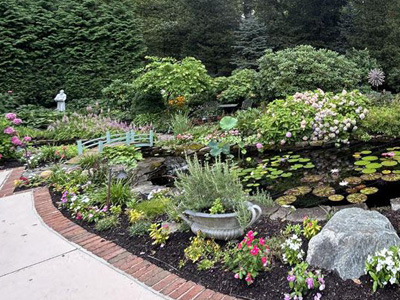15 Best Drought-Tolerant Plants for a Low-Maintenance Landscape
 Water conservation has become a critical concern for homeowners across many regions, making drought-tolerant landscaping an increasingly popular choice. These resilient plants adapt naturally to dry conditions, requiring minimal irrigation while maintaining vibrant colors and attractive textures throughout the growing season. Smart plant selection reduces water bills, eliminates the stress of constant watering schedules, and creates sustainable gardens that thrive during extended dry periods.
Water conservation has become a critical concern for homeowners across many regions, making drought-tolerant landscaping an increasingly popular choice. These resilient plants adapt naturally to dry conditions, requiring minimal irrigation while maintaining vibrant colors and attractive textures throughout the growing season. Smart plant selection reduces water bills, eliminates the stress of constant watering schedules, and creates sustainable gardens that thrive during extended dry periods.
Low-maintenance landscapes featuring drought-resistant plants by Mystic Water Gardens offer significant advantages beyond water savings. We recommend these plants for busy homeowners who desire beautiful outdoor spaces without intensive upkeep requirements or constant attention to watering systems.
Top Drought-Resistant Plant Varieties for Every Garden Zone
Selecting the right combination of these plantings ensures year-round visual interest while minimizing maintenance demands. Here are a few of the most popular choices:1. Lavender (Lavandula)
Mediterranean native lavender produces fragrant purple spikes that attract beneficial pollinators while repelling unwanted insects. This perennial herb thrives in full sun with well-draining soil, requiring water only during establishment periods. Harvest flowers for culinary use or dried arrangements.
2. Sedum (Stonecrop)
Succulent sedums store water in thick, fleshy leaves that create stunning ground cover or rock garden displays. These plants produce clusters of star-shaped flowers in various colors from late summer through fall. Popular varieties include Autumn Joy and Dragon's Blood.
3. Russian Sage (Perovskia atriplicifolia)
Silver-gray foliage and delicate purple flower spikes make Russian sage an excellent backdrop plant for perennial borders. This aromatic shrub reaches 3-4 feet tall and wide, creating natural windbreaks while attracting butterflies and hummingbirds to your garden space.
4. Ornamental Grasses
Native bunch grasses like buffalo grass, blue grama, and fountain grass provide textural contrast and movement in drought-tolerant landscapes. These perennials require minimal water after establishment while offering seed heads that feed birds during winter months.
5. Agave
Architectural agave plants create dramatic focal points with their sculptural rosette forms and sharp, pointed leaves. These slow-growing succulents come in various sizes, from compact varieties suitable for containers to massive specimens perfect for xeriscaping projects.
6. Yucca
Sword-like yucca leaves and towering flower stalks add desert elegance to any landscape design. These evergreen plants tolerate extreme heat and cold while producing cream-colored bell-shaped flowers that bloom for several weeks during summer.
7. Prickly Pear Cactus (Opuntia)
Flat, paddle-shaped segments and vibrant yellow or red flowers make prickly pear an attractive choice for southwestern-style gardens. These cacti produce edible fruits and require virtually no supplemental watering once established in appropriate climates.
8. Blanket Flower (Gaillardia)
Bright red and yellow daisy-like blooms provide continuous color from spring until first frost. These native wildflowers self-seed readily, creating natural drifts of color while attracting butterflies and beneficial insects to pollinator-friendly garden spaces.
9. Black-Eyed Susan (Rudbeckia)
Golden yellow petals surrounding dark centers create cheerful displays that brighten late summer gardens. These hardy perennials spread naturally through underground rhizomes, filling gaps in perennial borders while requiring minimal supplemental irrigation.
10. Catmint (Nepeta)
Fragrant gray-green foliage and spikes of blue or purple flowers make catmint an excellent edging plant for walkways and garden beds. This deer-resistant perennial blooms repeatedly throughout the growing season when spent flowers are removed regularly.
11. Lamb's Ear (Stachys byzantina)
Soft, silvery leaves create a striking textural element in drought-tolerant gardens while serving as an adequate ground cover for sunny locations. Purple flower spikes emerge in summer, though many gardeners remove them to maintain the plant's compact foliage appearance.
12. Desert Willow (Chilopsis linearis)
This small tree produces orchid-like flowers in shades of pink, purple, or white throughout the summer months. Desert willow adapts to various soil conditions while providing shade and vertical interest in xeriscape designs.
13. Sage (Salvia)
Culinary and ornamental sage varieties offer diverse options for drought-tolerant gardens, from compact purple-leafed kitchen herbs to towering autumn sage with bright red tubular flowers that hummingbirds find irresistible.
14. Zinnia
Heat-loving annual zinnias produce abundant blooms in virtually every color except blue, creating vibrant displays that last until hard frost. These fast-growing flowers self-seed readily and attract butterflies while tolerating hot, dry conditions.
15. Texas Red Oak (Quercus buckleyi)
This native shade tree develops brilliant red fall color while tolerating drought conditions better than most oak species. Acorns provide food for wildlife, and the tree's moderate growth rate makes it suitable for residential landscapes.
Create Your Sustainable Drought-Tolerant Garden Landscape
Successful implementation of these elements requires strategic planning and proper soil preparation techniques. Group plants with similar water requirements together to maximize irrigation efficiency and prevent overwatering sensitive species. Install drip irrigation systems or soaker hoses to deliver water directly to root zones, reducing evaporation losses while maintaining consistent soil moisture during establishment periods.Soil amendment plays a crucial role in drought-tolerant garden success, as most of these plants require excellent drainage to prevent root rot during occasional heavy rainfall events. Add coarse sand, perlite, or gravel to heavy clay soils to improve drainage characteristics. Apply organic mulch around plantings to conserve soil moisture, regulate root zone temperatures, and suppress weed growth that competes for available water resources.
For more information on our services with plants for a low-maintenance landscape, call Mystic Water Gardens at 818-424-6836. Alternatively, you can contact us via this Online Form, and one of our representatives will get back to you.
Back to Blog Page


